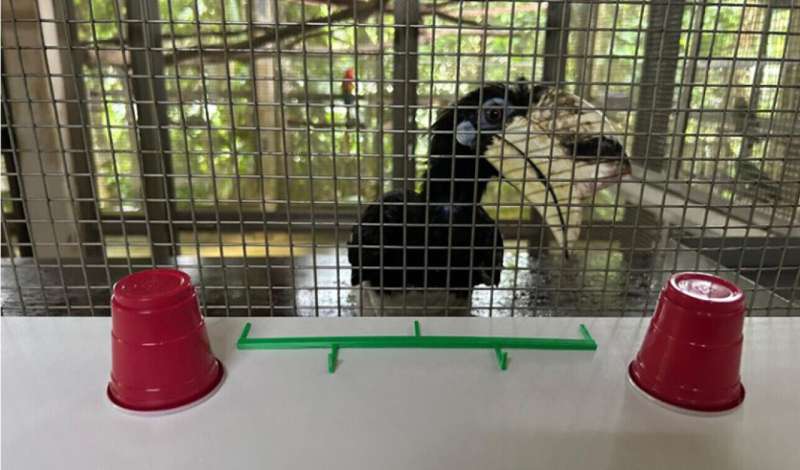February 20, 2024 report
This article has been reviewed according to Science X's editorial process and policies. Editors have highlighted the following attributes while ensuring the content's credibility:
fact-checked
peer-reviewed publication
trusted source
proofread
Oriental pied hornbills found to have object permanence levels comparable to apes

A pair of animal behaviorists at the National University of Singapore, has found, via testing, that Oriental pied hornbills have object permanence levels comparable to apes. In their paper published in the journal Biology Letters, Ruitong Yao and Elias Garcia-Pelegrin, describe how they tested object permanence levels in several captive Oriental pied hornbills.
Object permanence is the ability to remember or know that something still exists even if it is out of sight. Prior research has shown that just two bird species have such an ability; corvids and parrots. In this new effort, the research team has found that a third species, Oriental pied hornbills, also have the ability.
To learn more about object permeance in Oriental pied hornbills, the researchers tested six of the birds that are housed at a test facility at the National University of Singapore. They chose to test the birds because prior research has shown that they demonstrate a form of object permanence in nature—males bring treats to females and hatchlings despite not being able to see them because they are hidden behind protective constructs. Each of the birds was tested in multiple ways, with tests growing progressively more difficult.
All the tests involved first training the birds to show where a treat was sitting by pecking at it, or in its direction. The birds were then placed one by one in a cage with a screen on it that they could look through as the researchers manipulated and hid treats beneath small red cups. After each manipulation, the bird was asked to indicate where it thought the treat was, by pecking through the screen at one of the red cups.
In the initial stage, a treat was placed under a cup as a bird watched, it was then asked to point out which cup was hiding the treat. Over the next several stages, a treat was placed under various cups, then moved to other cups before the bird was asked where it was.
The final test involved invisible displacement, where a bird was allowed to watch as a treat was placed under a box, it was then prevented from seeing where the treat was moved to—but it had not been moved at all. Upon showing the birds that the treat was not under a cup, half of the birds shifted to pecking at the box, assuming it had been left there.
More information: Ruitong Yao et al, Oriental pied hornbills ( Anthracoceros albirostris ) solve invisible displacement tasks in a test of Piagetian object permanence, Biology Letters (2024). DOI: 10.1098/rsbl.2023.0547
Journal information: Biology Letters
© 2024 Science X Network



















